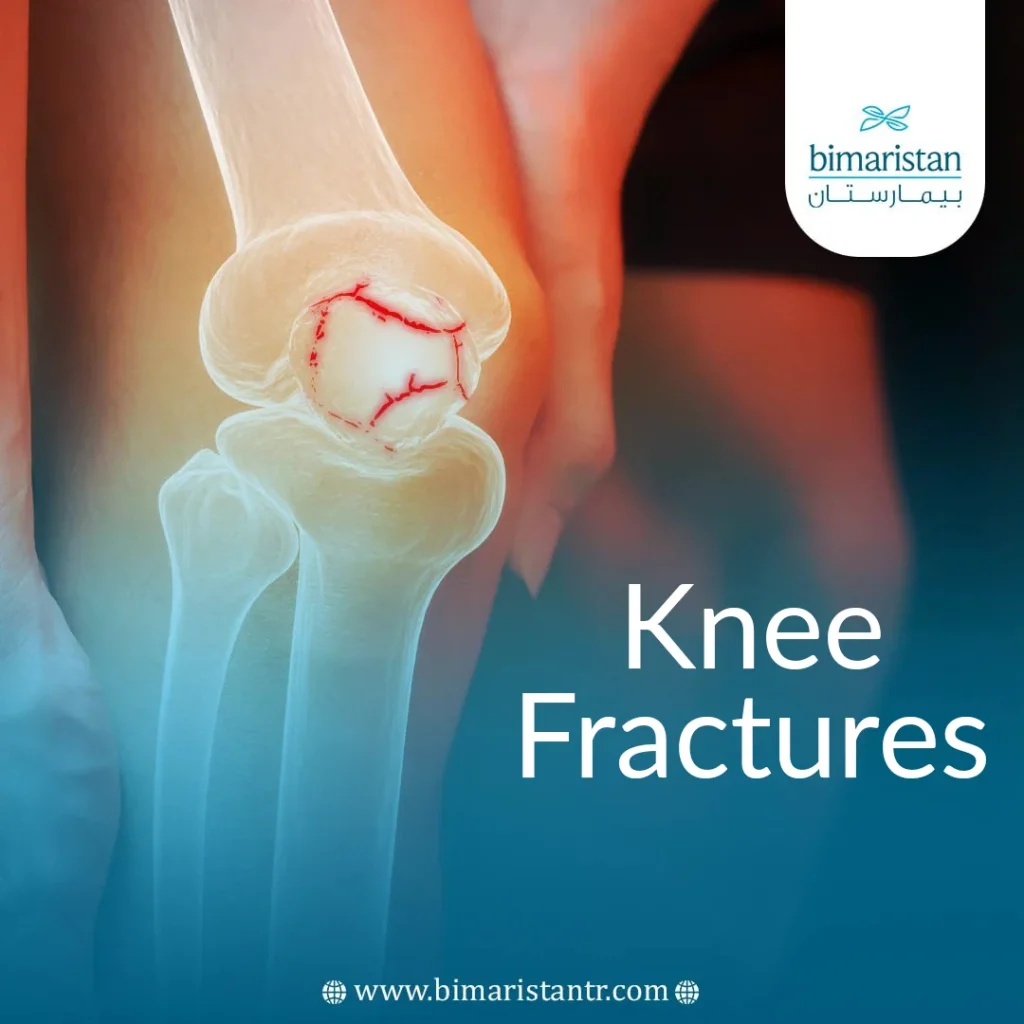Knee fractures come in various shapes and degrees depending on the severity of the bone fracture. The symptoms of the fracture are evident; when you experience a knee fracture, you will feel severe pain and difficulty moving.
Knee fractures (broken knee) usually occur after blunt trauma, especially motorcycle accidents or falls from a great height. However, some factors can weaken your knee bones and make them prone to fractures with minimal force.
The knee joint consists of the convergence of three bones: the tibia, femur, and patella (kneecap). Fractures can occur in any of these bones or all of them simultaneously. Follow along to learn about knee fractures, fractured knee signs, their types, and appropriate treatment.
Overview of knee fractures
Although patella fractures are the most common among knee fractures, accounting for only 1% of bone fractures in the body, they are relatively uncommon.
The patella is a rounded bone located in the front part of the joint. It is surrounded by ligaments and tendons that connect muscles and bones, ensuring an appropriate range of motion for the knee joint and protecting it from injuries.
Knee fractures may be accompanied by damage to the ligaments or tendons surrounding the bone due to the scattering of broken knee fragments and their impact on other joint parts. Therefore, fractures are classified into degrees and types based on the severity of the injury and the degree of joint damage.
The treatment of fractures depends on the type and severity of the fracture. Treatment may be simple for minor injuries, while more complex injuries may require surgery.
Knee fracture symptoms
A cracked patella tends to reveal itself immediately, with clear signs appearing on the affected individual after the accident or injury. The most immediate symptom is severe knee pain, along with other symptoms such as:
- Swelling and bruising around the knee, even with a minor fracture
- Inability to move the knee, especially when attempting to bend or straighten it
- Difficulty walking or standing due to increased pain when applying weight to the joint
- Deformation in the external shape of the knee, especially with severe fractures
- Protrusion of bone outside the skin in cases of open fractures of the patella
- A sound resembling bone cracking
If you notice any of these symptoms after sustaining a knee injury, consult a doctor immediately. In most cases, fracture symptoms do not take long to appear after a blunt accident. Of course, confirming and diagnosing a knee fracture requires X-ray imaging.
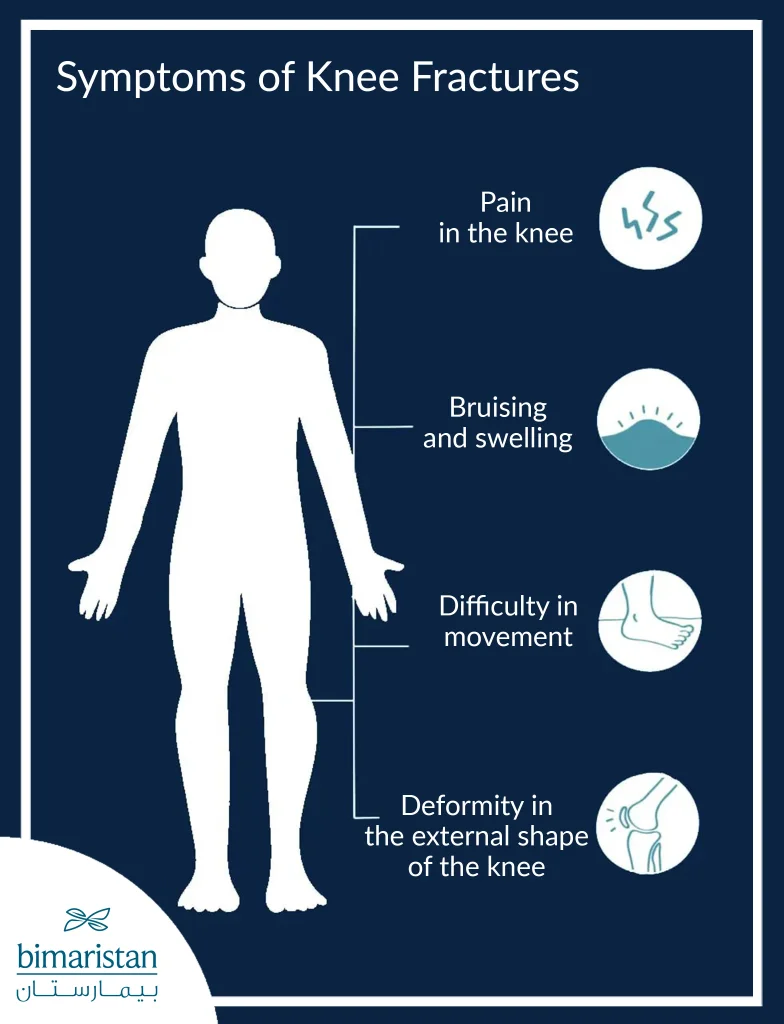
Knee fracture classification
As mentioned earlier, knee joint fractures have been divided into several types and forms according to the severity of the joint injury. This classification helps select the appropriate treatment method and determine the need for surgery.
Four main types of fractures occur at the knee joint level:
Closed knee fractures
In closed fractures, the skin above the fracture site remains intact, meaning that the fractured bone did not protrude through the skin’s outer surface, and the injury did not cause damage to the skin in that area.
This fracture type is easier to treat and usually does not lead to serious complications.
Open knee fractures
In this type, the skin above the fracture site is damaged either because bone fragments from the fractured bone scatter and protrude out through the skin or because severe injury causes tearing of the skin.
This type is more complex than closed fractures, and its treatment is more complicated. It often damages the tissues surrounding the bone and requires a longer time to heal and recover.
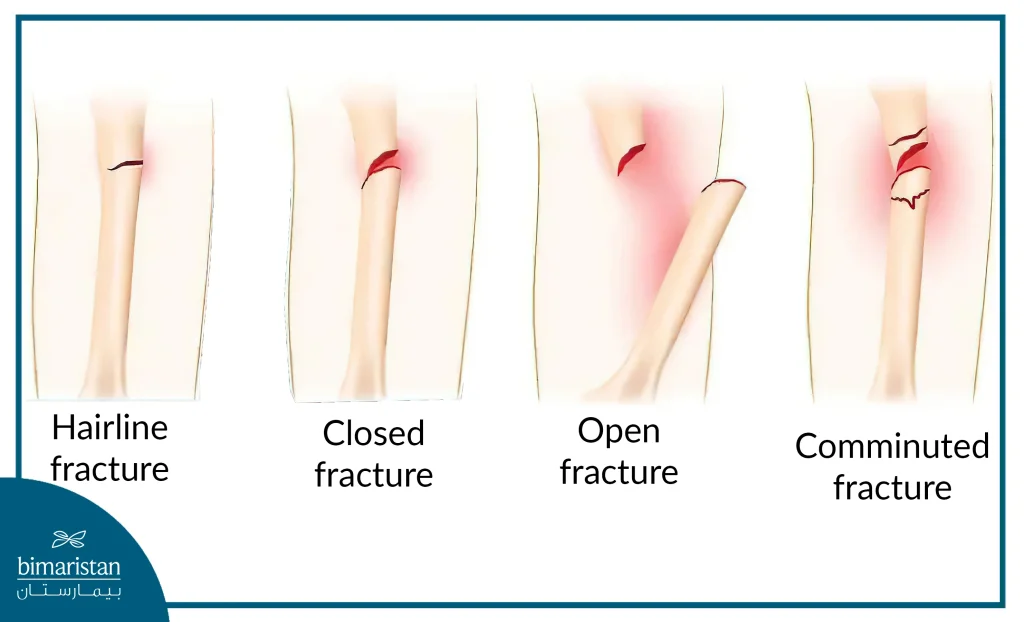
Knee fracture types
The term “classification” refers to what a person or doctor can visually observe, while types are invisible to the naked eye and require X-ray images for identification. Among the types of knee joint fractures are the following:
Stable knee fractures
When the fractured bone does not move out of its normal position, it is called a stable fracture. This means that the bone is broken but remains in the same place without moving, which is a good sign.
Unstable knee fractures
In this type, the fractured bone moves out of its normal position, causing the connected bone ends to separate from each other. This fracture requires surgery to connect the ends and restore the bone to its previous shape.
Comminuted knee fractures
When the bone is shattered and fragmented into 3 or more pieces, it is known as a comminuted fracture. If the bone pieces are limited to two, it is known as a non-comminuted fracture. There is also another type known as a hairline fracture, which is just a small crack in the bone often seen in athletes due to stress. It is rare and difficult to diagnose.
Diagnosis of knee fractures
After observing the symptoms and listening to the patient’s history, if a suspicion arises with the orthopedic doctor of a bone fracture, the following steps and tests are performed to confirm the diagnosis:
Physical Examination
Examining the knee and looking for signs of a fracture is an important step in the diagnosis. The presence of bruises and swelling supports the possibility of a bone fracture, in addition to the examiner palpating and attempting to move the knee joint to check for pain or difficulty in movement.
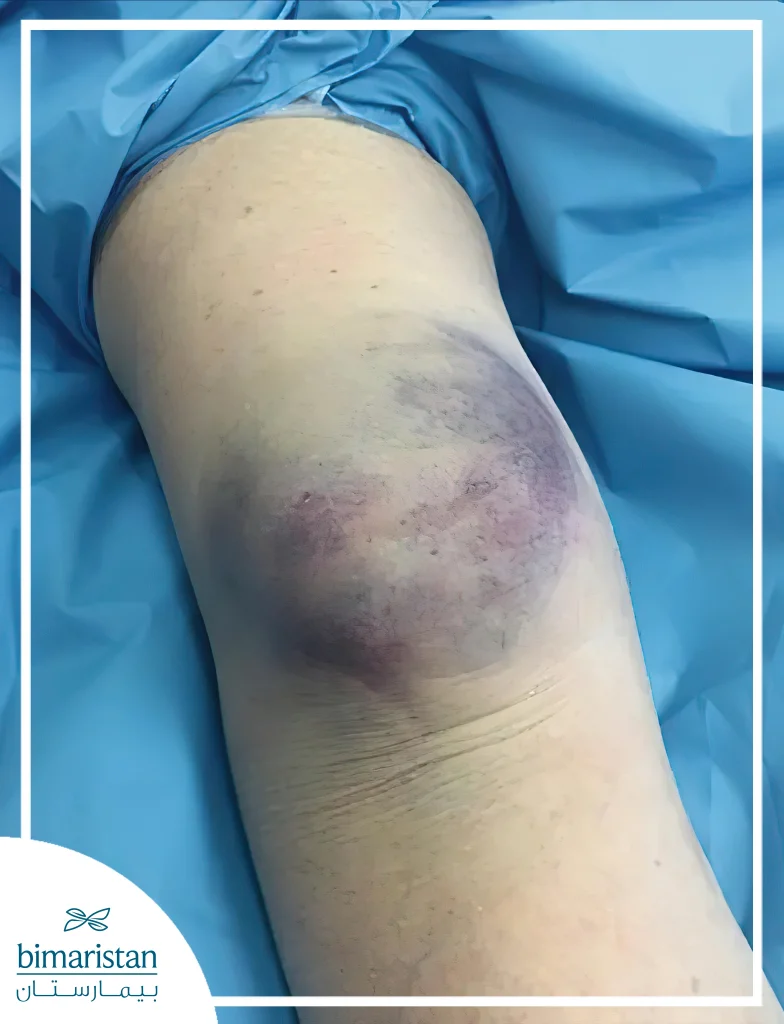
X-ray Imaging
X-ray imaging helps visualize tissues with high density in the body, such as bones. This imaging technique is used to detect the presence of bone fractures and determine the type and severity of the fracture.
The role of imaging techniques is not limited to detecting bone injuries and fractures but is also used to rule out other injuries, such as knee cartilage tears.
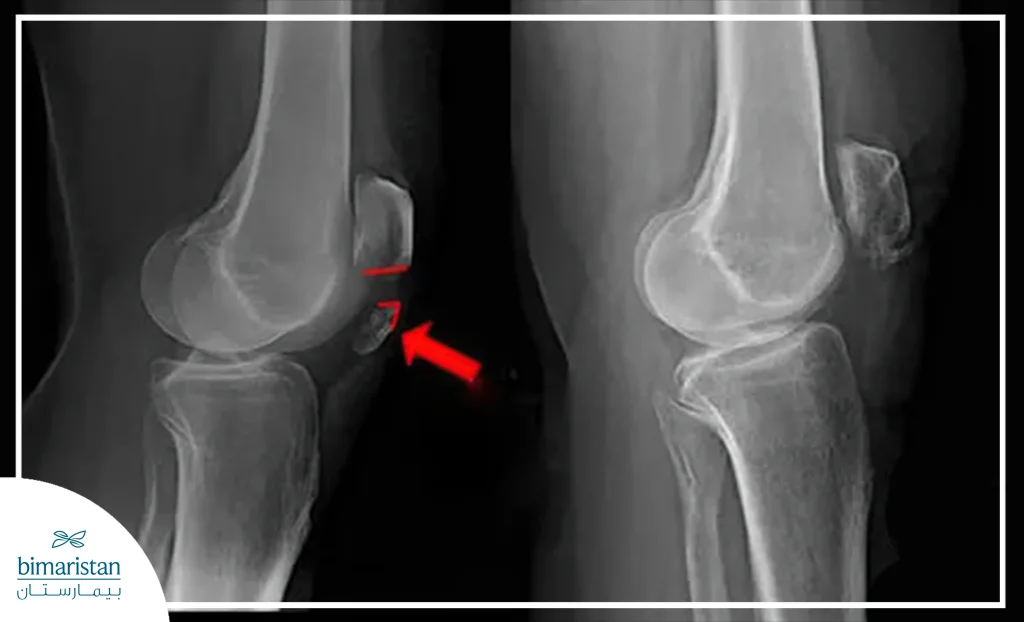
Treatment of Knee Fractures
There are several ways to treat various cases of knee fractures, as the choice of the appropriate method depends on the type and severity of the fracture. It is not always necessary to resort to surgery to manage fracture injuries.
Non-Surgical Treatment for Knee Fractures
In cases of mild stable fractures, using a knee brace to stabilize the joint and prevent movement facilitates bone healing and speeds up the process. Pain relief can also be achieved by using pain relievers and anti-inflammatory medications such as ibuprofen or by applying ice to the fracture site.
Rest and avoiding bearing weight on your knees are important, and your doctor will advise you on the necessary bed rest period before you can return to walking. You may need a rest period ranging from 4 to 6 weeks, which can vary depending on the severity of the knee fracture. The use of crutches during this period may be beneficial.
Certainly, physical therapy plays a significant role in rehabilitation and regaining strength and independence after recovering from fractures.
Surgical Treatment of Knee Fractures
When bone fragments and parts of the bone scatter outside their normal position due to the fracture, weakening and difficulty in proper fracture healing occur. In such cases, surgery is required to rejoin the bone pieces together to allow for proper fracture healing.
The surgical procedure usually involves the use of screws or wires to connect and fix the bone ends together, in addition to removing small bone fragments and debris.
The surgeon tries to preserve bone tissue as much as possible by avoiding the removal of large sections of the bone unless necessary. If damage to the surrounding ligaments is observed, the doctor will repair this damage as well.
Recovery After Knee Fractures
There is no fixed recovery period for all patients, as it varies from person to person depending on the nature and severity of the injury, the patient’s overall health, and age. However, the average recovery time ranges from 3 to 6 months for moderate fractures and may be longer in advanced fracture cases.
During this time, individuals are prohibited from engaging in physical activities that stress the knees and undergo physical therapy aimed at improving and restoring muscle strength, as well as accelerating healing and recovery.
The specialist may offer some tips to speed up fracture healing, including getting adequate amounts of vitamin D through sun exposure or dietary supplements and avoiding smoking, as it slows down bone healing.
Recently, a new method has emerged to accelerate cell regeneration and treat knee problems through knee plasma injections, which are still under study but have proven effective in treating many knee problems such as cartilage degeneration and arthritis.
Regarding modern techniques, Turkey has provided a technique for accelerating bone healing using electrical stimulation, which enables patients to return to their normal lives and recover from fractures faster than usual.
Risk Factors for Knee Fractures
Weak, low-density bones are more prone to fractures than healthy, strong bones. Factors that make bones weak and predisposed to fractures include:
- Aging, as elderly knee bones are weaker than those of young people
- Osteoporosis
- Smoking and alcohol
- Previous knee joint injuries
The risk of knee fractures increases in individuals who engage in sports that require strong physical joints, such as football or basketball. In conclusion, although knee fractures may be somewhat rare, they require special care and long-term recovery. Knee fractures may be accompanied by damage to surrounding tissues such as tendons and ligaments, so it is necessary to classify fractures into various types and forms to determine appropriate treatment steps.
References:
- Patella Fractures and Extensor Mechanism Injuries, aul S. Whiting MD, Director of Orthopaedic Trauma Research, Assistant Professor – University of Wisconsin.
- Patellar Fractures in Adults, J. Stuart Melvin, MD, Samir Mehta, MD.



